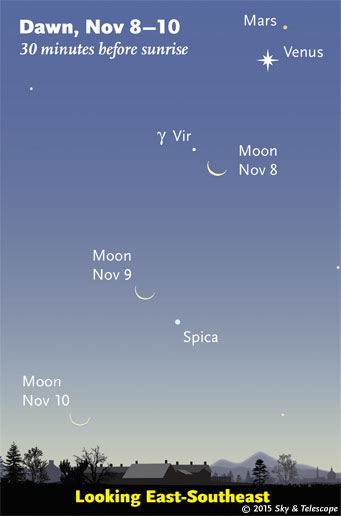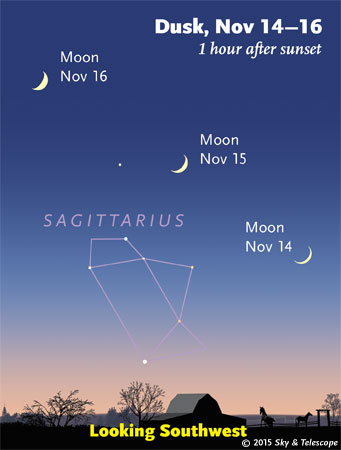Taurid fireballs. As predicted, this has become the best year for bright meteors from the Taurid shower since its memorable fireball activity in 2005. Reports have been coming from around the world. Occasional brilliant meteors should continue through about Tuesday, November 10th. Keep looking up! See our article: Taurid Fireballs Continue.

Friday, November 6
• In dawn tomorrow morning (Saturday the 7th), the waning crescent Moon shines strikingly paired with Venus. Faint Mars makes it a triangle! Jupiter looks on from above them.
Saturday, November 7
• Algol should be at its minimum brightness, magnitude 3.4 instead of its usual 2.1, for a couple hours centered on 5:20 p.m. EST according to recently revised predictions. Watch Algol rebrighten for several more hours through the course of the evening. Comparison-star chart.
• In the dawn of Sunday the 8th the waning crescent Moon hangs below the Jupiter-Mars-Venus lineup, right about in line with them. Can you make out 3rd-magnitude Gamma (γ) Virginis in the Moon's vicinity?
Sunday, November 8
• Cassiopeia stands on end high in the northeast after nightfall this month. If you have a telescope, surely you look in on Cassiopeia's clustery deep-sky sights from time to time. But how about T Cassiopeiae and its companion? This pair of stars offers a striking color contrast when T Cas is near its maximum brightness of about magnitude 8.3, as it is now. See the November Sky & Telescope, page 45.
The finder map there also includes eight lovely open clusters right around Cassiopeia's W pattern.
Monday, November 9
• Near Cassiopeia lies faint Lacerta the Lizard, surprisingly rich in deep-sky objects considering its naked-eye modesty. Or maybe not so surprising — it's athwart the northern Milky Way. See Sue French's Deep-Sky Wonders telescopic guided tour in the November Sky & Telescope, page 50. Lacerta's brightest open cluster, large and loose NGC 7243, is magnitude 6.4 with a nice double star inside.
• Happy 81st birthday, Carl Sagan (November 9, 1934 – December 20, 1996). If only.
Tuesday, November 10
• Take a look at Cassiopeia again. The third segment of its W pattern, counting from the top, points roughly straight down. Extend it twice as far down and you're at the Double Cluster in Perseus. At magnitudes 4.3 and 4.4, this pair of star-swarms is apparent to the unaided eye if you have a dark sky. They're visible in binoculars or a small, wide-field telescope from almost anywhere.
Wednesday, November 11
• The brightest star on the northeastern side of the November evening sky is Capella, magnitude zero. It's below Perseus. Look well to its right (about three fists at arm's length) to locate the Pleiades, the size of your fingertip at arm's length. Below the Pleiades blinks orange Aldebaran.
Thursday, November 12
• By about 8:30 Orion is clearing your eastern horizon (depending on how far east or west you live in your time zone). Aldebaran is high above Orion. Above Aldebaran are the Pleiades. Aldebaran and the Pleiades always serve as Orion's announcers.
Friday, November 13
• By about 8 or 9 p.m. this week, the Great Square of Pegasus stands in its level position very high toward the south. It's straight overhead if you're at the latitude of Miami. Its right (western) side points very far down toward Fomalhaut. Its eastern side points down less directly toward Beta Ceti (Diphda), not as low.
If you have a very good view down to a dark south horizon, and if you're no farther north than roughly New York or Denver, picture an equilateral triangle with Fomalhaut and Beta Ceti forming its top two corners. Near where the third corner would be is Alpha Phoenicis, or Ankaa, in the constellation Phoenix. It's magnitude 2.4, not very bright but the brightest thing in the area. Have you ever seen anything of this constellation before?

Saturday, November 14
• The waxing crescent Moon is back in the evening twilight. As twilight fades away, can you make out any last stars of summery Sagittarius to its left, as shown here? Bring binoculars!
__________________________
Want to become a better astronomer? Learn your way around the constellations. They're the key to locating everything fainter and deeper to hunt with binoculars or a telescope.
This is an outdoor nature hobby. For an easy-to-use constellation guide covering the whole evening sky, use the big monthly map in the center of each issue of Sky & Telescope, the essential guide to astronomy.

Once you get a telescope, to put it to good use you'll need a detailed, large-scale sky atlas (set of charts). The standards are the little Pocket Sky Atlas, which shows stars to magnitude 7.6; the larger and deeper Sky Atlas 2000.0 (stars to magnitude 8.5); and once you know your way around, the even larger Uranometria 2000.0 (stars to magnitude 9.75). And read how to use sky charts with a telescope.
You'll also want a good deep-sky guidebook, such as Sue French's Deep-Sky Wonders collection (which includes its own charts), Sky Atlas 2000.0 Companion by Strong and Sinnott, the bigger Night Sky Observer's Guide by Kepple and Sanner, or the beloved if dated Burnham's Celestial Handbook.
Can a computerized telescope replace charts? Not for beginners, I don't think, and not on mounts and tripods that are less than top-quality mechanically (meaning heavy and expensive). As Terence Dickinson and Alan Dyer say in their Backyard Astronomer's Guide, "A full appreciation of the universe cannot come without developing the skills to find things in the sky and understanding how the sky works. This knowledge comes only by spending time under the stars with star maps in hand."
This Week's Planet Roundup
Mercury has sunk away into the glow of sunrise.
Venus, Mars, and Jupiter continue their changing display in the eastern sky before and during dawn. Venus is the brightest at magnitude –4.4. Jupiter is –1.8, and Mars, between them (closer to Venus), is much fainter at +1.7. Watch their pattern change from morning to morning. Venus, the lowest, is descending; Jupiter and Mars are moving higher.
Saturn (magnitude +0.6) is getting lost in the afterglow of sunset very low in the west-southwest. Bring binoculars. Good luck.
Uranus (magnitude +5.7, in Pisces) and Neptune (magnitude +7.8, in Aquarius) are high in the southeast and south, respectively, in early evening. Finder charts for Uranus and Neptune.
__________________________
All descriptions that relate to your horizon — including the words up, down, right, and left — are written for the world's mid-northern latitudes. Descriptions that also depend on longitude (mainly Moon positions) are for North America.
Eastern Standard Time (EST) is Universal Time (UT, UTC, or GMT) minus 5 hours.
__________________________
“This adventure is made possible by generations of searchers strictly adhering to a simple set of rules. Test ideas by experiments and observations. Build on those ideas that pass the test. Reject the ones that fail. Follow the evidence wherever it leads, and question everything. Accept these terms, and the cosmos is yours.”
— Neil deGrasse Tyson
 0
0
Comments
You must be logged in to post a comment.